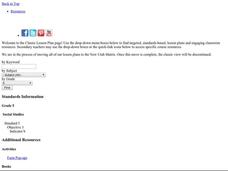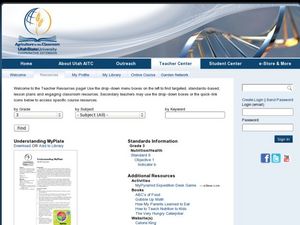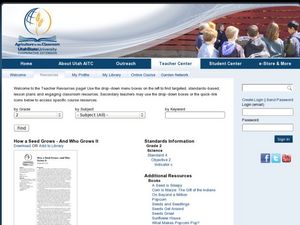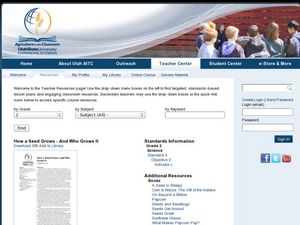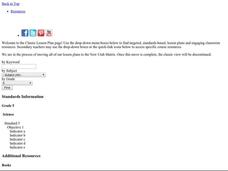Curated OER
Dietary Guidelines/Food Pyramid
Learners study the recommended Dietary Guidelines for Americans and the Food Guide Pyramid. They discuss the foods they eat, watch a video about the Food Pyramid and examine actual foods portioned out into recommended serving sizes.
Curated OER
Name That Cheese!
Students explore a variety of cheese. In this cheese lesson, students sample 4 different cheeses produced from cow's milk and recorded their observations about the cheeses prior to identifying them.
Curated OER
Hand Washing: I Can Handle It
Third graders explore biology by viewing a germ video in class. In this sanitation instructional activity, 3rd graders identify the importance of washing hands and complete several on-line germ safety activities. Students view a video in...
Curated OER
Understanding MyPyramid
Fifth graders investigate serving sizes. In this serving size activity, 5th graders study the food pyramid paying special attention to proper serving sizes of food. Resources are provided.
Curated OER
Where Does It Come From?
Fifth graders explore free trade. In this free trade lesson plan, 5th graders discover which commonly found products are made in the United States and which originate from other countries. Students explore which countries are better at...
Curated OER
It All Began With a Bean
Students explore human anatomy by participating in hands-on activities. In this digestive system lesson plan, students read the book It All Began With a Bean and discuss the process of food digestion in our body. Students utilize soda...
Curated OER
Handwashing and Dishwashing
Students discuss the importance of correct hand washing and practice washing dishes. Individually, they examine the germs on their hands with Glo-Germ and compare it to the germs after washing their hands. To end the lesson, they...
Curated OER
Fruits and Vegetables in the Food System
Young scholars examine the importance of local markets. In this horticulture lesson, students examine the importance of local markets and food systems that can provide profit for growers, freshness, variety and quality.
Curated OER
Diet, Exercise and AIDS
Students research AIDS and the role of diet and exercise with the disease. In this AIDS lesson, students listen to a mini lecture about the diet and exercise needs of people who have AIDS. Students learn about alternative therapies to...
Curated OER
The Secret Life of a French Fry
Students explore where the food they eat comes from. In this food lesson, students look at agriculture and food production. They follow the production of a french fry and discuss all the steps it goes through before being served.
Curated OER
Healthy Diet
Third graders recognize what constitutes a healthy diet and explore if their diet is healthy. In this healthy diet instructional activity, 3rd graders listen read books and explore the food pyramid to find a balanced diet. Students...
Curated OER
Now You Have It, Now You Don't
Fifth graders explore the value of service. In this consumer practices lesson, 5th graders investigate natural resource protection needs. Students participate in the preservation of natural resources through service learning.
Curated OER
Learning From Leaves: Adaptations To Differing Light Levels
Students, in groups, examine plants with different light levels. They are given plants from a tropical and desert region. They write a hypothesis at the beginning of the experiment.
Curated OER
How a Seed Grows and Who Grows It
First graders explore biology by viewing PowerPoint presentations in class. In this plant life lesson, 1st graders identify the life cycle of a plant and how to properly plant a seed outside. Students view a movie about plant life and...
Curated OER
Microorganism Multiplication
Sixth graders explore biology by viewing video clips in class. For this microorganism identification lesson, 6th graders identify the types of organisms that can feed small animals such as algae and protozoans. Students view video clips...
Curated OER
Farm Products Help Me Grow
Students view a display of empty food containers (or illustrations). They select a food and decide as a class if it has an animal or plant origin. Students view a display of common farm animals that are commonly eaten (cow, pig, chicken,...
Curated OER
Animals and Environments
Students listen to stories and identify animals and their young. In this animals lesson, students view videos about farm animals and create illustrations to show how animal babies change over time. Students discuss how they care for...
Curated OER
Exploring Texture In the Garden
Students explore the garden environment. In this garden environment lesson, students investigate the needs and parts of a plant. Students discover the differences between fruits and vegetables while creating their own garden.
Curated OER
Four Seasons
Students investigate the four seasons in a year. In this seasons lesson, students explore the weather during each season. Students illustrate each season with pictures.
Curated OER
Who's Who?
Students explore biology by identifying animals and their environments. In this animal characteristic instructional activity, students read assigned text about farm animals, how they are raised, and what they are used for in our society....
Curated OER
How a Seed Grows: And Who Grows It
Second graders explore botany by viewing video clips in class. In this seed growth lesson plan, 2nd graders identify the types of seeds that grow specific plants and what the optimal conditions are for growing seeds. Students view a...
Curated OER
Bird Buffet
Fifth graders study traits of different bird beaks. In this bird lesson, 5th graders explore the function and usefulness of different inherited traits of birds.
Curated OER
Peanut Butter Broccoli
Fifth graders explore food production by viewing DNA presentations. In this genetic engineering lesson, 5th graders discuss the foods they typically eat at home and how many common foods are engineered in a way that can produce a bigger...
Curated OER
Rock, Paper, Scissors
Fifth graders explore genetic traits. In this genetic traits lesson, 5th graders investigate dominant and recessive traits. Students identify similar traits between a parent organism and its offspring.






